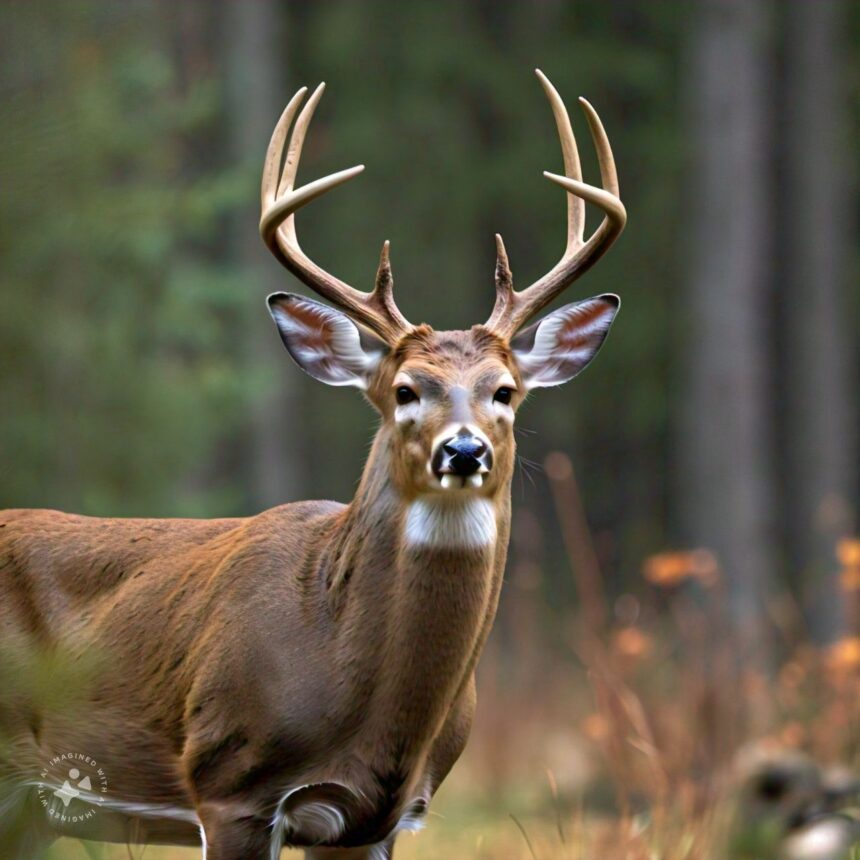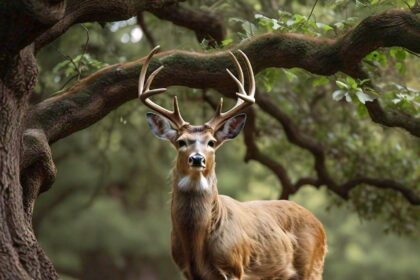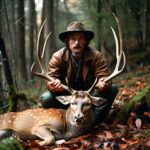Are you ready to learn the secrets of successful whitetail deer hunting? These creatures can be both fascinating and challenging for hunters. But do you know the details of their behavior, habitat, and the best hunting strategies?
Whitetail deer are found all over the United States, offering hunting seasons in most states. Whether you like bowhunting or rifle hunting, understanding whitetail deer can improve your skills. This article will teach you about their rut behavior and deer habitat, helping you become a trophy buck hunter.

Exploring whitetail biology and their habits will help you hunt them better. You’ll learn how to use deer food plots and deer calling to improve your hunting. This journey will change how you hunt deer forever.
Ambush Hunting: The Most Common Whitetail Strategy
Ambush hunting is the top choice for whitetail hunters. Most hunters set up ambushes on or near farmland. They look for where deer like to eat, which changes often.
Scouting For Deer Feeding Areas
Deer eat many things like alfalfa, beechnuts, acorns, apples, and dogwood limbs. To hunt successfully, you need to know where they eat and move to find them.
Identifying Whitetail Bedding Areas
Deer sleep in places hard for predators to see, like marsh edges, briar patches, and creek bottoms. These spots are great for setting up an ambush.
Targeting Travel Corridors And Funnels
After finding where deer sleep and eat, look for their paths. Setting up ambushes along these paths can help you catch them off guard.
Learning Ambush Hunting can make you a better hunter, no matter your gear or where you hunt.
Still Hunting: The Art Of Stalking Whitetails
Stand hunting from high spots is common today, but still hunting, or stalking whitetails, is still a top choice. It’s a patient way to hunt that needs great woodsmanship skills. Hunters can get close to deer without them noticing.
Ideal Conditions For Still Hunting
Great days for still hunting are overcast and damp with little wind. These conditions help hide the hunter’s sounds and movements. Hunters use the land’s cover and shadows to move quietly through the deer’s home.
Essential Gear For Still Hunters
- Short-barreled firearm or compact bow for close-range shots
- Neutral-toned camouflage to blend into the surroundings
- Lightweight, quiet footwear that allows for a stealthy “fox walk”
Techniques For Successful Still Hunting
For successful still hunting, stay calm and focused. Use the “fox walk” to move quietly. Always be alert and use your senses to find deer before they see you. Patience and hard work are key, as you may walk a lot before seeing a deer.

Stand hunting is popular, but still hunting is a special challenge. By knowing the best conditions, gear, and techniques, hunters can improve their chances of success in this traditional way of hunting deer.
Whitetail Deer: Behavior And Habitat
Whitetail deer are known for their amazing Whitetail Behavior. They have sharp senses that make them hard to spot. Hunters must be very careful to avoid them. These deer like to stay in thick, dense areas like marsh edges and creek bottoms.
Whitetails change what they eat all year. Hunters need to be flexible and watchful to find them. An adult whitetail deer eats about 5-7 lb of food daily. The amount they need changes with the seasons, especially for pregnant and nursing females, and males during the fall rut.
In spring, whitetail deer are most active at dawn and dusk, known as crepuscular. In summer, they move around more during the day. During the late autumn rut, they can be active at any time.
When it gets cold, deer leave their summer spots when snow is about 15 inches deep. They travel up to 12 miles to reach their winter spots, called “deer yards.” These places have lots of trees for protection from the cold.

The breeding season, or rut, for white-tailed deer happens from late autumn to early winter, peaking around November 10th. Most fawns are born in late May or early June, weighing about 3-6 lb.
Morning Hunting: When And Where To Hunt Whitetails
Morning hunting is a great way to catch whitetail deer, especially during the rut. But, it’s important to know the best times and places to hunt. Understanding when and where to hunt in the morning can make a big difference in your success.
Optimal Morning Hunting Scenarios
The best times for morning hunting are when it’s cold and calm, with lots of open areas like hardwood forests. Make sure your stand is at least 200 yards away from where deer eat and sleep. This helps you get in and out without scaring them.
During the rut, hunting in the morning near where does and bucks sleep can be very successful. Bucks look for does in these spots, so you might catch them there.
When To Avoid Morning Hunts
Not all mornings are good for hunting. Hunting too much in the morning can make deer change their ways, making evening hunting less effective. Also, if you’re not careful getting in and out, you might scare away all the deer.
Knowing when and where to hunt in the morning can really help you succeed. The rut is a great time for morning hunting, so don’t miss out.
Stand Setup And Selection For Whitetail Hunting
Setting up your hunting stand correctly is key for whitetail hunting success. Whitetail deer have sharp senses, so using elevated stands is a must. These stands keep your scent and shape hidden from deer, making them less likely to notice you.
Look for stand spots in travel paths, funnels, and between feeding and resting areas. Think about wind direction, cover, and how well you can see when placing stands. Don’t skip a good spot just because the tree isn’t perfect. Use trees that are good enough, even if they’re not the best.
Don’t risk your safety when picking a tree for your stand. Using stands that fit different tree shapes helps you find the best spot. Remember, 93% of successful stand placement comes from understanding deer travel patterns and behavior. Watch for air currents, thermal patterns, and deer movement to guess where they’ll go and set up your stands.
Conclusion
In conclusion, understanding the behavior and habitat of whitetail deer is essential for any hunter looking to improve their skills and increase their success. By studying their biology, feeding habits, and movement patterns, hunters can better anticipate where and when to find deer.
Utilizing ambush hunting and still hunting techniques can offer unique challenges and rewards, with each method requiring specific gear and strategies to be effective.
Embark on your hunting journey with these insights, and you’ll find that the more you learn about whitetail deer, the more rewarding and fulfilling your hunts will become. Happy hunting!








